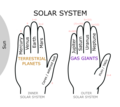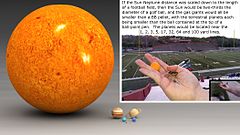File:Solar System Hand Mnemonic.png

Original file (2,800 × 2,500 pixels, file size: 309 KB, MIME type: image/png)
Captions
Captions
Summary edit
| DescriptionSolar System Hand Mnemonic.png |
English: This image is a hand mnemonic used to help students learn the Solar System. The fingers of the left hand represent the terrestrial planets. The fingers of the right hand (palm upward) represent the gas giants, with Saturn as the ring finger. The left thumb shows the sequence of the dwarf planet Ceres among the asteroid belt. The right thumb indicates the dwarf planet Pluto along with other trans-Neptunian objects. (To represent the Sun, the hands could be positioned in relation to the head or some other object.)
With the fingers and thumb taken together, the left hand represents the Inner Solar System and the right hand represents the Outer Solar System. Moons and ring systems for each planet and dwarf planet are indicated in red. The total number of moons is broken out into two sets, with the first being the number of large moons that have been rounded by hydrostatic equilibrium, and the second number being the remainder of known moons that are not in hydrostatic equilibrium. By analogy to planets, this split could be considered as separating "major moons" from "minor moons". Sets of parentheses indicate major and minor ring systems, and are exclusive to the gas giants. Uranus stands out because while the names of Roman gods are used for other planets and the two dwarf planets shown, Uranus is Greek (Roman equivalent is Caelus). Solar system objects not represented include other asteroids (including Jupiter's Trojans and near-Earth asteroids), comets and cis-Neptunian objects (including Neptune's Trojans and centaurs).
For an excellent presentation of the major moons in the Solar System, see this image (from lesud.com). |
| Date | |
| Source | Own work |
| Author | Tdadamemd |
Licensing edit
- You are free:
- to share – to copy, distribute and transmit the work
- to remix – to adapt the work
- Under the following conditions:
- attribution – You must give appropriate credit, provide a link to the license, and indicate if changes were made. You may do so in any reasonable manner, but not in any way that suggests the licensor endorses you or your use.
- share alike – If you remix, transform, or build upon the material, you must distribute your contributions under the same or compatible license as the original.
File history
Click on a date/time to view the file as it appeared at that time.
| Date/Time | Thumbnail | Dimensions | User | Comment | |
|---|---|---|---|---|---|
| current | 22:49, 9 January 2013 |  | 2,800 × 2,500 (309 KB) | Tdadamemd (talk | contribs) | Reloading latest edit with moon count. |
| 11:29, 9 January 2013 |  | 2,800 × 2,500 (309 KB) | Tdadamemd (talk | contribs) | Listed in red are the number of moons for each planet and dwarf planet. Each is broken out into two sets, with the first being the number of large moons that have been rounded by hydrostatic equilibrium, and the second number is the remainder of known ... | |
| 08:35, 9 January 2013 |  | 2,800 × 2,500 (292 KB) | Tdadamemd (talk | contribs) | Identifying the left hand as representing the inner solar system, and the right hand as the outer solar system. | |
| 08:03, 9 January 2013 |  | 2,800 × 2,500 (277 KB) | Tdadamemd (talk | contribs) | Changing '&' to '/', because the previous notation seemed to indicate that Ceres was not part of the asteroid belt and that Pluto was not a TNO. | |
| 08:03, 7 January 2013 |  | 2,800 × 2,500 (280 KB) | Tdadamemd (talk | contribs) | User created page with UploadWizard |
You cannot overwrite this file.
File usage on Commons
There are no pages that use this file.
File usage on other wikis
The following other wikis use this file:
- Usage on en.wikipedia.org
- Usage on id.wikipedia.org
Metadata
This file contains additional information such as Exif metadata which may have been added by the digital camera, scanner, or software program used to create or digitize it. If the file has been modified from its original state, some details such as the timestamp may not fully reflect those of the original file. The timestamp is only as accurate as the clock in the camera, and it may be completely wrong.
| Horizontal resolution | 28.35 dpc |
|---|---|
| Vertical resolution | 28.35 dpc |
| File change date and time | 11:21, 9 January 2013 |
